Event Planning

Invitation for the opening events
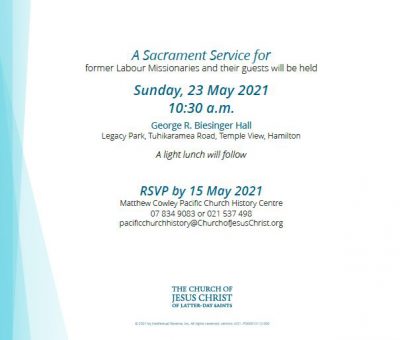
Invitation for the Sunday events
Elder and Sister E’s plan for the opening of the Sacrifice and Consecration exhibit included much more than a short welcoming program and a reception with light refreshments. What they envisioned was a two-day event beginning with a pōwhiri (abbreviated from the full-blown Māori welcome ceremonies we had witnessed on other occasions, but still including speeches and music), followed by the hura (unveiling) and ribbon-cutting, and then a “high tea” reception. (Time for guests to actually peruse the exhibit seemed only an incidental part of the proceedings.) The next day—Sunday 23 May—a special sacrament meeting would be held for our labor missionary guests so the many expected to come from out of town would not overwhelm any of the local wards. After that, a light lunch would be served, a few more musical items would be performed, and the celebration would wind down as the elderly labor missionaries kissed each other farewell and went home.
Jo-Ena took charge of organizing the food and decorations, while Hori assumed responsibility for arranging the programs. It was a given that Elder Y of the Pacific Area presidency, as the presiding Church authority, would be the main speaker at both the welcome and the Sunday sacrament service, but other talks needed to be assigned and music prepared. The task should have been fairly straightforward, but was complicated by the fact that we had assured the families of former labor missionaries who lived far away or were too frail to leave their nursing homes that the events would be recorded so that all who wanted to participate could do so by video if not in person. Our promise to tape the meetings put us up against the same rule we had encountered when planning for Hui Tau 2021: Area Authority Seventies should not be recorded, and neither should sacrament meetings. The problem was finally resolved by dividing the Sunday meeting into two parts: a sacrament service at which Elder and Sister Y would speak, followed by a “devotional” where a few former labor missionaries could share their thoughts. The first meeting would not be recorded, but the second—along with Saturday’s program—would be.
Other tasks ranging from addressing envelopes to setting up sound equipment were delegated to a host of volunteers. Jo-Ena’s first call was to her friend Paula, famous throughout the Hamilton Stakes for her fabulous parties and holiday decorations. Marilyn, a Church History volunteer who is also a stake Relief Society president, mustered more women to prepare food and decorate tables. A few of these were professional caterers who happily offered—not unlike supporters of The Project during the 1950s—to donate their time, talents, and tableware as their way of honoring the labor missionaries. As a result, plans for both Saturday’s high tea and Sunday’s lunch seemed to get more elaborate and the menus more extensive every day. Three different kinds of soup would supplement an assortment of finger sandwiches, scones, sweet slices, and cupcakes at the tea (at which, in case you were wondering, no tea of any kind would be served). The next day’s three-course lunch would feature lamb, pork, and vegetables roasted hangi-style. One of Elder E’s seafaring buddies who now lives in Napier offered to fill a refrigerated case full of freshly caught fish—including as many pāua (New Zealand abalone) as he could legally harvest—and send it up to Hamilton as his contribution to the midday meal that Hori continued to refer to as a “light lunch.” (When Nancy challenged Elder E after he insisted on that description for the invitation, he explained his reasoning thus: “Under-promise and over-deliver!”)
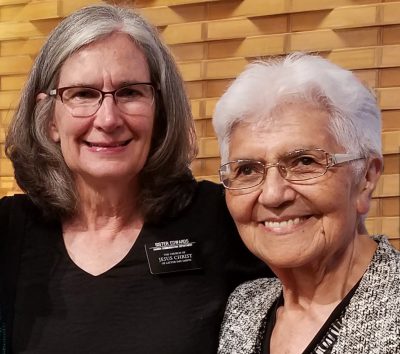
Sister Kara E with Aunty Lil in February
An unexpected and very sad complication for the MCPCHC staff was that ten days before the opening, Aunty Lil, the legendary former labor missionary and choral conductor who had been asked to direct a choir for the occasion, suddenly died. Lil’s daughter eventually agreed to carry on with the music that her mother had been preparing, but for a few days, the exhibit opening was nearly forgotten as the energy of the whole Temple View community was redirected toward mourning the passing of a woman beloved by all. We are fortunate that Lil had recorded a long interview about her experiences in the Church and as a labor missionary several years ago, and clips from that interview are an important part of our exhibit. We also are fortunate to have met this amazing woman, who had the uncanny ability to make everyone feel as if you were her dearest friend. Her funeral (which Michael missed because he nobly volunteered to take guide duty at the museum while the rest of us attended the service) not only featured tributes but a lot of great music from the singers Lil had encouraged and trained—evidence of her enduring legacy.
Five days before the opening of Sacrifice and Consecration, Elder and Sister E asked us for a short video that could be shown during the welcome program to introduce guests to the exhibit. What they had in mind was a brief overview of the whole labor missionary/temple construction experience, but with the exception of the long documentary Quinn and his team were producing, we had nothing to fit that description. All our videos were either the personal recollections of individuals or focused on a specific subject such as the Ceremonial Welcome. Hori and Jo-Ena decided to join our next virtual meeting with Quinn so they could ask the Film and Video crew to assemble a short video using clips from the documentary that would be suitable for showing at the program.
“You mean like a trailer for the longer film?” Quinn asked.
“Yes, like a trailer,” they said. “No more than five minutes long.”
“Sure, we can put something together for you,” Quinn said. “When do you need it?”
“By Saturday morning—your Friday afternoon.”
“Ooh—that’s tight,” he replied, “but we’ll see what we can do.”
Two days before the opening, as we were getting ready for work, we received a text from Sister E with a request: Would Nancy please set aside time first thing to finish typing the souvenir program she wanted to provide for the guests? The file needed to be sent to the printer ASAP. For Nancy, it was not a matter of “finishing” the program, because until then, no one had ever asked her to do it. She had assumed someone else was taking care of it, but apparently the task had never been assigned because Hori was so focused on simply putting together the final agenda. So as soon as our staff devotional was over, Nancy asked Jo-Ena for the program information so she could get started. “I don’t have it; you’ll have to ask George,” Jo-Ena replied (using the anglicized version of Elder E’s first name that most people know him by). Elder E, however, was nowhere to be found, so Nancy was instructed to go ahead and help Catherine, Diane, and Michael clean and fill the artifact cases as planned—a painstaking process that took all morning (described in Part 2 of this series). Before we went to lunch, Nancy found Elder E and asked him for the program information so she could start creating the document as soon as she had eaten. “I’ll send it to you,” he said; but no sooner had Nancy opened the email when another one came advising her to hold on because some last-minute program changes had not yet been resolved. So she went upstairs to greet the volunteer museum guide who had just come on duty for the afternoon and give her an orientation to the new exhibit. When she returned to the workroom about 45 minutes later, Hori told Nancy that the agenda issues still had not been resolved, but then asked, “Will you please help Aunty Rangi with the name tags?”
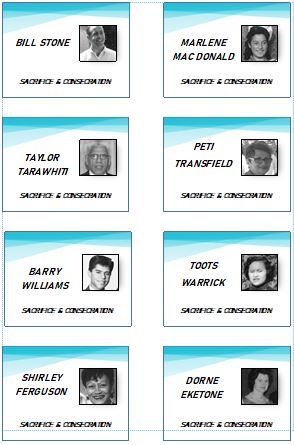
Name tag design template
Nancy expected this task to involve sliding printed name cards into little plastic sleeves, but she soon discovered otherwise. The name tags had not yet been printed. Rangi had assembled a digital file containing photos of about half the labor missionaries invited to the opening, but that was it. No badge template had yet been formatted, and no names had been typed.
“Rangi, do you know what size the tags are supposed to be?” Nancy asked.
“No, dear,” Rangi replied, “You’ll have to ask Sister E.”
Sister E was out shopping, picking up items for the reception. Nancy sent her a text asking what size the badge holders were.
“Badge holders are too expensive,” Jo-Ena replied. “We are laminating them. Use the same font as the invitations with a color coordinated frame. Will trust your judgment as to size.”
Nancy thus spent a frustrating half hour trying to figure out how to reset her MS Publisher ruler to show centimetres instead of inches. Finally giving up, she asked Michael for help.
“What are you trying to do?” he asked,
“Divide an A4 sheet into eighths for the name tags,” she explained.
“Name tags? I thought you were doing the program,” he said.
“I thought I was, too, but apparently the program has not yet been finalized, so Hori asked me to help Rangi with the name tags, which means that I’m now designing a template. So will you please help me figure out how to reset the ruler to centimetres and do the math?”
While Michael took over Nancy’s computer to help her create a template, she went to the toilet. On her way back to her desk, Hori stopped her and said, “I have the program information now. Jo-Ena would like it done this afternoon so she can get it to the printer.”
Nancy said, “Uh, I can either do the name tags or I can do the program, but I can’t do both this afternoon. Which would you like me to do?”
“Oh, that’s right,” said Elder E. “If you’re working on the name tags, carry on. I guess I can do the program.”
Michael overheard this conversation and told Hori, “I’m about done with a name tag template for Nancy, so I can help you with the program while she adds the photos and types the names.”
About fifteen minutes later, Jo-Ena approached Nancy’s desk and asked for the program file. “I need to get it to the printer ASAP.”
Nancy said, “Hori told me to do the name tags, so Michael is going to do the program.”
Michael said, “I just now got the program information from Hori. What size do you want it to be? Do you want it to be folded? Tell me what you envision. And do you want one program for both the welcome and the Sunday meeting, or do you want two separate programs?”
Jo-Ena described what she had in mind: two separate programs, printed on half sheets of A4 paper, same as the invitations, with the program outline on one side and the words to the songs on the other.
Michael raised his eyebrows. “Words to the songs?”
“Yes,” Jo-Ena explained, “so we don’t have to pass out hymn books.”
It was a challenge to fit all the required text onto two sides of a half sheet in a point size large enough for aged eyes to read, so Michael persuaded Jo-Ena to go with a full sheet, folded in half. One of the hymns was to be sung in te reo Māori and no digital version was available, so Michael had to painstakingly copy each word from the Māori hymn book, making sure they were spelled correctly and all the macrons were in the right places—a task as anxiety-producing for him as dividing an A4 sheet into eighths had been for Nancy.
Once the name tag template had been created, Nancy’s next task was to crop all the images Rangi had collected to a standard size and shape. As she looked down the long list of names for which there were no corresponding photographs, Nancy realized that she had seen pictures of many of the missing during her months of examining labor missionary photos. Rangi must have searched her sandbox for image files labeled with the names of individuals, but Nancy knew that many more faces could be found by searching group photos filed under different names. Not wanting any former labor missionaries to feel slighted because their name tags didn’t have pictures like the others, Nancy began her own hunt through the sandbox.
It must have been past 6:00 when Jo-Ena, looking over Nancy’s shoulder at the project in progress, suddenly realized that each name tag would have to be individually laminated because if she ran a full sheet of eight through the laminator and then cut it apart, the film would no longer stick to the paper. She thus abandoned the lamination idea and decided to go back to the office supply store for plastic badge holders. Of course, now the name tag template would have to be adjusted to fit the new dimensions. Sensing that Nancy’s patience with the whole project was wearing thin, Jo-Ena told her, “Don’t worry about the name tags. Paula and I will take it from here.”
Minutes earlier, Hori had approached Michael and said, “There’s been another change to the program …”
At that point, Michael and Nancy decided that even though neither the program nor the name tags were finished, it was time to go home.
The Eleventh Hour
When we walked into the office a little before 9:00 on Friday 21 May, the day before the opening, we found Wendy and Rangi sitting together at Rangi’s desk, searching the digital files for a few more photos to go on the name tags. It had gotten to the point where they were reviewing video footage of labor missionary reunions from the 1980s and ’90s, trying to identify individuals so they could capture screenshots of people still on the “missing” list. Virginia, our valiant volunteer office aide, was slicing up pages of name badges that had already been printed and slipping the cards into their plastic holders.
Grateful that she had been relieved of further responsibility for the name tags, Nancy went to her desk and opened her email. Michael had just done the same thing, so both of them found a message from Quinn at about the same time: he had sent the completed “trailer.” The lovely little 4-minute video Quinn had created not only provided a perfect introduction to the exhibit but also demonstrated his consummate skill at moving an audience. It included some of the best sound bites from the labor missionary interviews, and was set to an appropriately stirring score. After we’d wiped the tears from our eyes, Michael went to Elder E and asked, “Can we gather everyone in the theatre? Quinn just sent the ‘trailer,’ and we think everyone should see it.”
Other than the incomplete Ceremonial Welcome film that Eva had shown everyone months earlier, this was the first video related to the Sacrifice and Consecration exhibit that most of our cohort had seen, and the first Michael and Nancy had viewed on the big screen. It was thrilling to watch, and thrilling to see how the video affected the other members of our Church History team. Wendy summed it up: “We’d better have some tissue boxes on hand in the theatre tomorrow, because we’re going to need them for sure!”
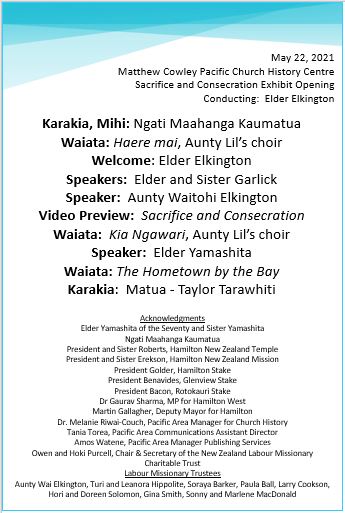
Opening Program design
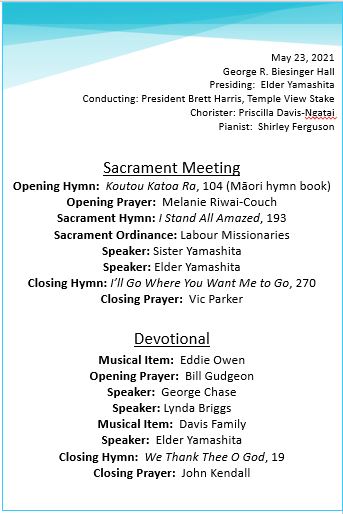
Sacrament Meeting and Devotional Program design
Returning to our desks, Michael finished typing the two programs and then turned them over to Nancy to proofread. After the corrections were made, he cried out with exultation, “I want everyone to know that the programs are done! I said they’d be finished by noon, and it’s only 11:58!”
After lunch, Nancy turned her attention to another document. Along with the introductory video, Quinn had sent her the latest version of the narration for the full documentary for copy editing Although the longer film had been inspired by the Sacrifice and Consecration exhibit project, it was not meant to be part of the exhibit itself, and we didn’t expect it to be ready in time for the opening—but we did hope it would be finished within the next few months.
Although at 5:00 p.m. the MCPCHC was still a hive of activity as others set up the lunch room and adjacent conference room for the next day’s tea, Michael and Nancy realized that there was nothing more for us to do until the exhibit installers arrived at 7:00, so we left and went out to dinner with Kara and Jeff, who had just come down from Auckland for the opening. As contributors of historic photographs for the exhibit, they had received a formal invitation, but also as Church Communications specialists they had been assigned to cover the opening for the media. It felt good to relax with old friends for a couple of hours before the big event.

Installation of another modular wall
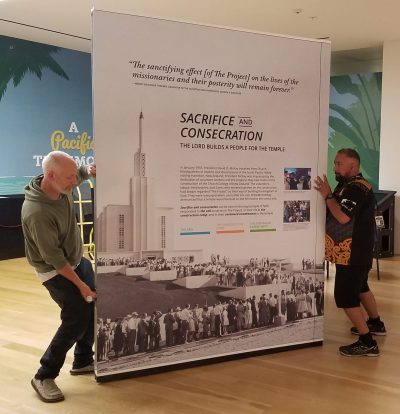
Installation of the exhibit’s introductory panel
After we had seen Kara and Jeff back to their hotel, we returned to the MCPCHC about 8:00, expecting to find the exhibit installation in progress. We were dismayed to find the building completely dark and no installers’ truck in the carpark, so we went home. It was not the first time the professional contractor who installs and maintains museum components had failed to show up when expected, but the delay was stressful because it left even less time for us to ensure that the remaining elements of the exhibit were properly situated and that the electronic kiosks would work the way they were supposed to before the guests arrived. We assumed that Elder E would ring us as soon as the installers appeared, but at 10:00, when we still had heard nothing, Michael called him and learned that the crew had just begun to unload. We hurried back to the Centre.
An hour later, when we realized that someone had decided, without consulting us, to deviate from the carefully calculated layout for the modular walls that Wayne had devised, and that nothing we could say would change that inexplicable decision, we decided to leave. The final stage of the exhibit installation was thus out of our hands, and all we could do was pray that God would make up for any deficiencies.
(to be continued)
Oh my! There is nothing like last minute details going awry. Hopefully the confusion will resolve itself happily – I am on tenterhooks awaiting the next installment.